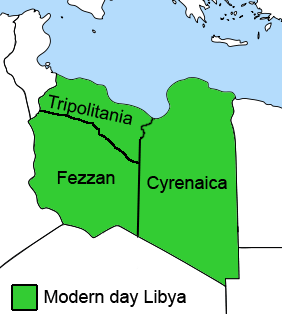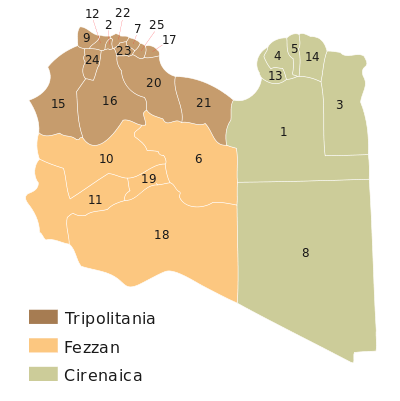Subdivisions of Libya
Subdivisions of Libya have varied significantly over the last two centuries. Initially Libya under Ottoman and Italian control was organized into three to four provinces, then into three governorates (muhafazah) and after World War II into twenty-five districts (baladiyah). Successively into thirty-two districts (shabiyat) with three administrative regions, and then into twenty-two districts (shabiyat). In 2012 the ruling General National Congress divided the country into governorates (muhafazat) and districts (baladiyat).[1][2] While the districts have been created,[3] the governorates have not.[4][5]

History
Prior to the Italian invasion of 1911, the area of Libya was administered as three separate provinces ("Vilayets") of the Ottoman Empire: Tripolitania, Fezzan, and Cyrenaica.
At first, Italy continued the tripartite administration, but soon consolidated the area into a single province/gobernatorate administered as the "Libyan Colony". Indeed, until about 1931 -when the last of the native resistance to the Italians was subdued- the area was divided into three historical regions (Tripolitania, Cyrenaica and Fezzan/"Territorio Sahara").
Then, in 1937, Italian governor Italo Balbo created the political entity called Libya. His Italian Libya was with four provinces and one territory: Tripoli, Misurata, Benghazi, Derna, (in the coastal north) and the "Territory of the Libyan Sahara" (in the Saharan south).[6]
After the French and British occupied Libya in 1943, it was again split into three provinces: Tripolitania in the northwest, Cyrenaica in the east, and Fezzan-Ghadames in the southwest.[7]
After independence, Libya was divided into three governorates (muhafazat), matching the three provinces of before, but in 1963 it was divided into ten governorates.
Provinces
The Provinces of Libya existed during the last period of colonial Italian Libya through post-independence Libya. The country was divided into provinces from 1934 in the colonial era to 1963 when the Governorates system was instituted.
Governorates
The Governorates of Libya (muhafazah) were an administrative division of Libya from 1963 until 1983. Initially there were 46 governorates-districts, called baladiyah, that were reduced to 25 in 1987.

| بلدية | Baladiyah | Main city | Population (in 1984) |
Number (on the map) |
|---|---|---|---|---|
| طبرق | Butnan | Tobruk | 94,006 | 3 |
| درنة | Darnah | Derna | 105,031 | 14 |
| الجبل الاخضر | Jabal al Akhdar | Bayda | 120,662 | 5 |
| المرج | Marj | Marj | 102,763 | 4 |
| بنغازي | Benghazi | Benghazi | 485,386 | 13 |
| إجدابيا | Al Wahat | Ajdabiya | 100,547 | 1 |
| الكفرة | Kufra | Al Jawf | 25,139 | 8 |
| سرت | Sirte | Sirte | 110,996 | 21 |
| مصراتة | Misratah | Misrata | 178,295 | 17 |
| Khoms | Khoms | 149,642 | 7 | |
| طرابلس | Tripoli (Tarabulus) | Tripoli | 990,697 | 22 |
| العزيزيه | Al 'Aziziyah | 'Aziziya | 85,068 | 2 |
| الزاوية | Az Zawiyah | Zawiya | 220,075 | 12 |
| النقاط الخمس | Nuqat al Khams | Zuwara | 181,584 | 9 |
| الجبل الغربي | Gharyan | Gharyan | 117,073 | 16 |
| Zlitan | Zliten | 101,107 | 25 | |
| الجفرة | Al Jufrah | Waddan | ? | 6 |
| الشاطئ | Ash Shati' | Brak | 46,749 | 10 |
| سبها | Sabha | Sabha | 76,171 | 19 |
| أوباري | Awbari | Ubari | 48,701 | 11 |
| غدامس | Ghadamès | Ghadames | 52,247 | 15 |
| Sawfajjin | Bani Walid | 45,195 | 20 | |
| مرزق | Mourzouq | Murzuk | 42,294 | 18 |
| ترهونة | Tarhounah | Tarhuna | 84,640 | 23 |
| يفرن | Yafran | Yafran | 73,420 | 24 |
| Total | 3,637,488 |
Baladiyat
In 1983, a new system was introduced dividing the country into forty-six districts (baladiyat also sometimes translated as municipalities). In 1987 this number was reduced to twenty-five.
Districts
On 2 August 1995, Libya reorganized into thirteen districts (sha`biyat - singular sha`biyah, also translated as municipalities or popularates). In 1998 this was increased to twenty-six districts (sha`biyat). In 2001 it was increased to thirty-two districts plus three administrative regions. Finally in 2007 the number was reduced to twenty-two districts.[8]
Basic People's Congresses
Under Gaddafi Libyan districts were further subdivided into Basic People's Congresses Arabic: مؤتمر شعبي أساسي (Mu'tamar shaʿbi asāsi ). Geographically they corresponded approximately to the level of a township or borough. In desert areas they often had an extensive land area with very low population, and were generally centered on, and named for, an oasis.
Overview
| year | number of divisions | name of divisions |
| historically (Persians) | 1(?) Barqa Shatrapani/Satrapy | Shatrapani/satrapy |
| historically (Greeks) | 1(?) Libya Satrapy | satrapy |
| historically Roman Empire | Roman Libya: Creta et Cyrenaica | province |
| historically Ottoman Empire (Ottoman Tripolitania) | Ottoman Tripolitania 1 | vilayet |
| colonised territory (1st phase) Italian North Africa, from 1912 to 1927 | 1[9] (Italian Libya) or 2[10] | governorate or province |
| colonised territory (2nd phase) Italian North Africa from 1927 to 1934 | 2 (Italian Cyrenaica,[11] Italian Tripolitania[12]) also Fezzan?[13] | governorate or province |
| colonised territory (3rd phase) Italian Libya from 1934 to 1937 | 3[14] (Cyrenaica, Fezzan, Tripolitania) or 4[15] or 1[16] | province |
| colonised territory (4th phase) Provinces of the Fourth Shore within the Italian Colonial Empire from 1937 to 1940 | 4[15] (Tripoli, Bengazi, Derna, Misurata) or 5[17] (along with Southern Military Territory) or 1 [16] | province[18] |
| colonised territory (5th phase) after World War II from 1943 to 1951 | 3[19] (Cyrenaica and Tripolitania were British; Fezzan-Ghadames was French) | province |
| after independence in 1951-1952 (Kingdom of Libya) | 3 | muhafazah (governorate) |
| in Kingdom of Libya after 1963 and in Libyan Jamahiriya after 1969 coup d'état | 10 | muhafazah (governorate) |
| after 1983 | 46 | baladiyah |
| after 1987-1988 | 25 | baladiyah |
| after 1995 | 13 | shabiyah (district) |
| after 1998 | 26 | shabiyah (district) |
| after 2001 | 32 | shabiyah (district) |
| after 2007 | 22 | shabiyah (district) |
| after 2013 | 99 to 108 | baladiyah |
Notes
- "للقانون رقم 59 لسنة 2012 ميلادية بشأن نظام الإدارة المحلية" [Law No. 59 for the year 2012 AD on the local administration system] (PDF) (in Arabic). اللجنة المركزية لانتخاب المجالس البلدية [The Central Committee for the election of baladiyah councils]. Archived (PDF) from the original on 27 March 2014.
- Bader, Mahmoud (April 2014). "Is Local Government in Libya the Solution?". Center for International Private Enterprise (CIPE). Archived from the original on 17 July 2014.
- "قرار مجلس الوزراء رقم 180 لسنة 2013 ميلادي بإنشاء البلديات" [Council of Ministers resolution No. 180 for the year 2013 AD the establishment of baladiyat] (PDF) (in Arabic). اللجنة المركزية لانتخاب المجالس البلدية [The Central Committee for the election of baladiyah councils]. Archived from the original (PDF) on 26 March 2014.
- Shanks, Tracy and Chemonics International Inc. (3 July 2014). "Libya Public Financial Management System Reform" (PDF). Asia Middle East Economic Growth Best Practices Project (AMEG). pp. 5–6. Archived from the original (PDF) on December 24, 2015.
- Vandewalle, Dirk (2015). "Libya's Uncertain Revolution". In Cole, Peter; McQuin, Brian (eds.). The Libyan Revolution and its Aftermath. Oxford, England: Oxford University Press. p. 35. ISBN 978-0-19-025733-0.
- Pan, Chia-Lin (1949) "The Population of Libya" Population Studies, 3(1): pp. 100-125, p. 104
- "Map of Libya 1943-1951" Zentrale für Unterrichtsmedien
- "Archived copy". Archived from the original on 2009-02-07. Retrieved 2009-05-25.CS1 maint: archived copy as title (link) شعبيات الجماهيرية العظمى – Sha'biyat of Great Jamahiriya, accessed July 6, 2007
- Italian Libya states "Italian Libya was formed from the colonies of Cyrenaica and Tripolitania which were taken by Italy from the Ottoman Empire in 1912".
- Italian North Africa states "from 1912 to 1934, as Tripolitania and Cyrenaica"
- Italian Cyrenaica states "was formed in 1927" and "In 1934, Cyrenaica became part of Italian Libya". Italian Libya states "Italian Libya was formed from the colonies of Cyrenaica and Tripolitania which were taken by Italy from the Ottoman Empire in 1912 after the Italo-Turkish War of 1911 to 1912".
Provinces of Libya states "From 1927 to 1934, the territory was split into two separate colonies, each run by their own Italian governor: Italian Cyrenaica and Italian Tripolitania". - Italian Tripolitania states "was formed in 1927" and "In 1934, Cyrenaica became part of Italian Libya". Italian Libya states "Italian Libya was formed from the colonies of Cyrenaica and Tripolitania which were taken by Italy from the Ottoman Empire in 1912 after the Italo-Turkish War of 1911 to 1912".
- Italian Libya states "Both Cyrenaica and Tripolitania, along with Fezzan, were merged into Italian Libya in 1934" but Italian North Africa states "from 1912 to 1934, as Tripolitania and Cyrenaica".
- Provinces of Libya states "In 1934 Italy adopted the name "Libya" as the official name of the reunified area, and administratively divided it up into the three provinces of Cyrenaica, Tripolitania and Fezzan".
- Italian Libya states "In 1934, [...] the colony (made up of the three Provinces of Cyrenaica, Tripolitania and Fezzan)" but also in the same paragraph "The colony was administered among four provincial governatores [...] and the southern military territory".
- Italian North Africa states "Indeed, from 1934 to 1940, Italian North Africa was then known as Libya as the North African territories were consolidated into one colony, Italian Libya". Later, the list confirms 1 division.
- Provinces of Libya states "In 1937 Cyrenaica and Tripolitania provinces split, with northern Cyrenaica becoming Benghazi and Derna provinces, and northern Tripolitania splitting into Tripoli and Misrata. Fezzan was not split, but the whole southern desert area was militarily".
- Italian Libya states "1939 a decree law transformed the commissariats into provinces".
- Italian Libya states "From 1943 to 1951, Tripolitania and Cyrenaica were under British administration, while the French controlled Fezzan".
Provinces of Libya states "French and British occupied Libya in 1943, it was again split into three provinces: Tripolitania in the northwest, Cyrenaica in the east, and Fezzan-Ghadames in the southwest".
